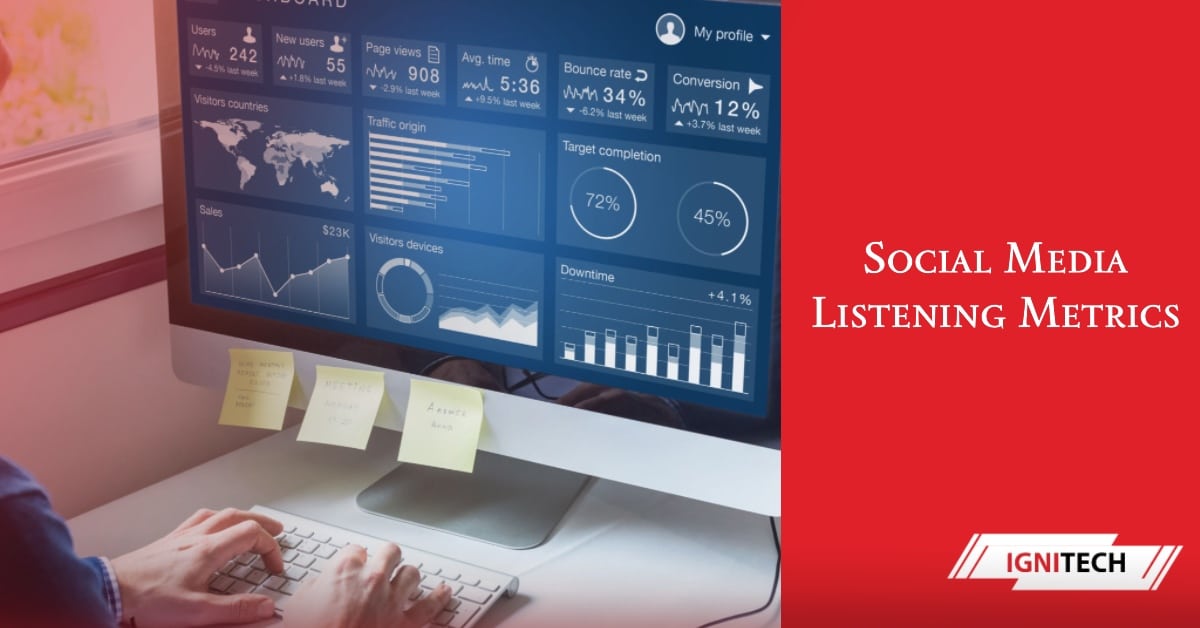Social media listening has become an invaluable practice for brands looking to understand their online reputation, connect with customers, and gain competitive intelligence. However, many organizations fail to move beyond simply monitoring mentions to actually measuring performance on key social media listening metrics. Without identifying social media listening metrics to benchmark and track over time, it’s impossible to prove the true value of your investment or optimize your strategy.
This article will provide an in-depth overview of the most essential social media listening metrics you should be tracking and how to set measurable goals based on volume, engagement, and business impact. By developing a performance measurement framework tied to tangible outcomes, you can elevate your listening program to deliver actionable insights that influence strategic decisions across departments. Let’s dig into the key social media listening metrics you need to know.
What are the metrics for social listening?

The foundation for any effective social listening program is clarity on the vital metrics that should be monitored on an ongoing basis. While the possibilities may seem endless for what can be measured, honing in on the metrics aligned to overarching brand objectives is crucial.
The key categories of critical metrics to track for social listening include:
Volume-Based Metrics
Volume refers to the amount of conversations your brand is generating as well as your share of voice in your broader industry. These foundational social media listening metrics indicate whether your content strategy and engagement approach is working to spark dialogue.
Mentions: The number of times your brand, products, or keywords are referenced online. This indicates awareness and mindshare.
Share of Voice: Your percentage of voice within your competitive set or industry based on online mentions. This allows benchmarking against rivals.
Sentiment: The tone of mentions based on social listening tools’ sentiment analysis algorithms. Aim for increasing positive sentiment over time.
Engagement Metrics
Engagement shows how well your owned social channels and online brand presence compels audiences to interact. These social media listening metrics demonstrate content resonance as well as how likely your fans are to amplify messages.
Click-Through Rate: The percentage of viewers of a tweet, post, or update who click through to linked content. This reveals content relevancy.
Amplification Rate: The percentage of spectators who further share content to their own feeds. This multiplier effect expands reach.
Business Value Metrics
While volume and engagement provide directional indications of brand health and content strategy success, the clearest measurement comes from quantifying how social data delivers tangible business impact. Connecting listening insights to actual sales and service outcomes is essential for proving overall ROI of your social media listening metrics program.
Sales Revenue Influenced: Directly attributed revenue from social campaigns and sales inquiries driven by listening data. This helps justify the program’s existence to executives.
Cost Savings from Insights: Operational savings from discovering pain points, avoiding PR crises, and identifying new innovations through social conversations.
Customer Service Cost Reductions: Lower service costs by addressing complaints early and enabling self-service resolution through social care automation.
How is social listening measured?
In order to regularly monitor your performance on both volume-based and business value social media listening metrics, it’s essential to have tools and processes in place for capturing data. Here is an overview of standard ways companies track listening KPIs:
Social Analytics Platforms: Services like Brandwatch, Sprout and Hootsuite centralize mention volumes and engagement rates in easy-to-use dashboards with historical comparisons. Leverage tools like geo-location tagging, sentiment scoring, competitive benchmarking and data exports.
Campaign Tracking: Just as social media marketing initiatives use UTM tags and customized links to measure ROI, add campaign parameters to landing pages where social care, market research, innovation ideas and other listening use cases direct traffic to. This connects downstream impact back to listen efforts.
Export Analytics to Spreadsheets: Download social data into Excel for regular analysis of social media listening metrics trends over time and performance reporting.
Conduct Surveys and Interviews: Getting qualitative feedback from customers helps connect suggestions and complaints spotted in social media to actions taken. Confirm listening drove improvements with anecdotal evidence.
CRM/Support Ticketing Integration: Link your social listening feeds and workflows directly to downstream platforms like sales inquiries, customer support tickets, innovation management portals and product improvement trackers to log qualitative feedback. This confirms listening’s role in driving ongoing improvement across functions based on social data signals.
Anecdotal Follow-up: Survey select customers engaged through social listening to dig deeper on their issues, ideas or interests. Confirm they felt “listened to” and taken care of. These qualitative stories bring numbers to life.
Overcome Data Disconnects: Since social data doesn’t automatically integrate into legacy business systems, analytics teams must creatively connect dots with IDs and correlation to confirm influence of social media listening metrics. This remains an ongoing challenge.
Tips for Setting Goals and Benchmarks

Approaching social media listening without clearly defined objectives and success social media listening metrics sets your program up for failure. You will lack context on what works so that you can double down on the highest-impact strategies.
Set Volume-Based Targets
Establish stretch targets for the number of brand mentions, share of voice percentage, positive sentiment ratio, etc. you want to reach by specific dates. Competitive and historical benchmarking informs reasonable goal levels.
Connect Listening Insights to Business Value
Make explicit goals for sales pipeline influenced, cost savings driven, and customer service metrics boosted by activating on social media listening metrics data. These value-driven goals instill stakeholder support.
This overview of crucial social media listening metrics—from foundational volume and engagement to business impact—provides a blueprint for developing a measurement framework tied directly to strategic goals for your brand.
Here are the critical social media listening metrics to guide your strategy:
Volume: Brand Mentions, Share of Voice, Sentiment
Engagement: Likes, Shares, Comments, Click Through, Amplification
Business Value: Revenue, Cost Savings, Customer Service Resolutions
Optimizing your KPI hierarchy and benchmarking allows keen focus on multiplying the social media listening metrics that matter most for your brand’s objectives.
What metrics are used to measure social media?
While a primary goal of social media listening is to move beyond vanity metrics to business value, overall social media measurement frameworks should take a portfolio view across both quantitative and qualitative KPIs including:
Quantitative Metrics:
- Impressions / Reach
- Engagement Rates
- Click-Through Rates
- Conversation Volume
- Positive Sentiment Ratio
- Sales Influenced
- Service Cost Reductions
Qualitative Metrics:
- Competitive Intelligence
- Market Trends Identified Early Warning for PR Crises
- New Innovation Opportunities
- Customer Friction Points
- Evolving Buyer Personas
Maintaining a holistic view prevents data blindspots: quantitative metrics underline effectiveness and impact to leadership while qualitative signals feed agility.
How do you analyze social listening data?
Effective analysis of social data to derive strategic insights requires:
Set Key Questions: What specifically do stakeholders want to learn from social listening analytics? Guide analysis around decision-making needs.
Dynamic Segmentation: Slice data different ways—by keywords, authors, sentiment, geos, channels—to uncover trends. Look at timeframes, events driving spikes.
Compare and Contrast: Contextualize by examining historical trends, competitor performance and channel nuances. Differences highlight what works.
Centralize Insights: Create a single portal for social analytics dashboards, excerpted verbatim posts, tagged and categorized qualitative insights, indexed reports and highlighted trends.
Distill Signals: Step back from granular data to identify overarching themes and conclusions. This synthesis fuels strategic priorities.
Drive Action and Accountability: Make insights actionable through task assignments, monitoring systems tied to products/services, permanent channels for two-way consumer dialogue, and continual social listening program optimization.
What is Social media Listening metrics vs Social Media Analytics?
Social Media Analytics:
- Focused on a brand’s owned social media properties and content
- Tracks quantitative metrics like followers, engagement, clicks, sentiment
- Optimizes organic and paid social strategies and community growth
Social Listening:
- Monitors external unsolicited conversations about a brand
- Surfaces consumer commentary on 3rd party sites like review sites, forums, blogs
- Provides voice of the customer insights to guide decisions
Key Differences:
- Social media analytics is inward-focused on owned channels, social listening is outward to broad web
- Media analytics on content resonance to optimize, Listening for consumer intelligence
- Owned touchpoint performance vs. overall brand reputation monitoring
Shared Linkages:
- Negative user-generated comments can inform social care approach
- Enthusiast conversations can inspire owned content
- Holistic view across internal and external data paints full picture
Tracking both metrics streams is crucial for customer-centricity. Social analytics enhances your channels while listening puts the customer first. Combining inward-outward understanding drives strategic advantage.
What is an Example of Social Media Listening?
Let’s explore a sample scenario showing the power of social listening.
A leading fast food chain rolls out a massive campaign promoting a revamped chicken sandwich to drive interest and conversation. Shortly after launch, the social listening analyst notices a spike in Twitter complaints centered in one metropolitan area about undercooked chicken leading to ill customers.
Rather than replying to irate tweeters one-by-one, the analyst urgently flags for the PR team and compiles all relevant posts to start investigation. Customer support also prepares for influx of inquiries.
Within hours, the negative “raw chicken” mentions proliferate across regions – a PR crisis is brewing! The social listening analyst identifies it began from one restaurant location before spreading. The supply chain team starts prompt inspection leading to discovery of a faulty oven temperature sensor.
A swift social listening process prevents bigger contagion across chains and markets. Targeted monitoring continues until volume of complaints return to normal. Follow-ups survey customers for experience improvements.
In this example, the company’s social listening program enabled early warning detection of a localized food safety shortcoming before it became widespread. By picking up the signals from unsolicited social conversations and mobilizing response teams, they averted damaging long-term effects that may have put their brand reputation, and even customers, at risk without urgent action.
This everyday scenario demonstrates how brands should have their “listening ears” on at all times to relevant social dialogues so that customer complaints or concerns don’t go unanswered. Proactive social listening facilitates agility.
How Does Social Media Monitoring Work?

For brands to aptly listen in on relevant social conversations and quickly activate on insights uncovered takes a coordinated orchestration of people, processes and technology. Constructing an end-to-end social monitoring framework requires:
Monitoring Scope: The first imperative is determining what should be tracked through expansive, multi-channel listening streams. Keywords pertaining to your brand name, products, executives, campaigns, competitors, industry trends and more build broad inclusion parameters to minimize blindspots. Listening must span both knowns and uncover unknowns.
Monitoring Tools: Software is crucial to ingest tens of thousands of daily conversations across networks like Twitter, Reddit, news sites and niche blogs seamlessly. Leading social listening platforms like Brandwatch, Sprout Social, and Hootsuite crawl broad sources to centralize relevant data feeds. Look for criteria like historical data access, competitive benchmarking, sentiment analysis, geo-location tagging, image harvesting and more for monitoring power.
Alert Trigger Configuration: Monitoring aims to surface important signals amongst the noise. Setting up intelligent, priority-based alert triggers ensures analysts immediately see when urgent issues emerge from the streams like crisis threats and complaints rising to thresholds based on volume, spikes or negative sentiment percentages. Create custom alerts for new competitors, product releases, campaign wins and more to stay attuned.
Sentiment Analysis: Monitoring tools automatically score unstructured textual data for positive, negative and neutral sentiment through NLP algorithms. Beyond aggregate numbers, examining the verbatim posts behind spikes uncovers issues and trends that warrant response like quality concerns, confusing messaging, evolving preferences and feature enhancement possibilities.
Competitive Benchmarking: Monitoring dashboards positioning your brand’s social metrics against competitors and broader category benchmarks lend external context on areas of strength and gaps needing improvement. Rather than internal echo chambers, competitive views promote realistic goal-setting.
Workflows and Collaboration: To rapidly activate on intelligence learned, implement workflows for sharing insights across departments through meetings, dedicated channels like Slack, tasking managers, and integrating listening streams into systems from support ticketing to product enhancement funnels. Close information gaps through collaboration.
Overall, coordinating technologies, processes, alert systems and cross-functional partnerships allows brands to get internal stakeholders on the same page through efficient monitoring that keeps a finger on the pulse of target customer conversations. Ongoing social media monitoring fuels proactive brand and experience optimization rather than reactive fire-fighting.
Why Do We Measure Social Media Metrics?
Many organizations jump into social media without concrete reasons why they engage in these platforms or what specifically they aim to achieve. By defining targeted objectives and putting measurement frameworks in place connected to strategic goals, brands can quantify impact rather than wasted vanity metrics.
Here are compelling reasons for comprehensive social media measurement:
Prove ROI: CEOs and CFOs want justification for resources invested in social. Directly tying metrics like sales influenced, service cost reductions and innovation opportunities to social engagement calcifies commitment even further up the chain of command.
Optimize Content Resonance & Community Growth: All brands seek to organically expand their follower base and deliver content prompting reactions. Benchmarking performance metrics by type/timing of posts, campaign elements and audience segments highlights what works to replicate.
Enhance Customer Experiences: Social media facilitates another real-time touchpoint for brands to connect with consumers. Tracking metrics like response times, sentiment and support issue resolution rates helps optimize this two-way dialogue.
Compare Against Competitors: One brand operating in an isolated silo lacking external context misses where gaps exist compared to industry benchmarks. Social listening tools providing competitive visibility push realistic goal-setting.
Overall, social media metrics underpin DATA-DRIVEN decisions on where to improve channel engagement, support customers better, double down on high-performing content and campaigns, spot threats early and focus innovation efforts. Measurements guide strategic priority and resource allocation through numbers, not hunches.
The Role of the Social Media Listening Analyst
FAQs
The top metrics used to measure social media performance include impressions, reach, engagement rate, click-through rate, conversation rate, sentiment, conversions, and ROI. Both platform analytics and third-party tools provide data.
Best practices for analyzing social listening data include:
- Tracking trends over time
- Benchmarking against competitors
- Identifying spikes for investigation
- Segmenting by keywords, authors, sentiment
- Comparing performance by channel/campaign
- Highlighting relevant excerpts to add context
- Connecting insights to business outcomes
A social listening platform providing historical data, sentiment analysis, competitive benchmarking and CRM/analytics integration. Custom reporting abilities also useful for measuring metrics.
Tools with share of voice tracking or partnership options for enhanced data access facilitate industry benchmarking. Derive key metrics based on rivals’ performance.
Connect sales revenue directly influenced and costs reduced through monitoring trends, sparking innovation, and enhanced care from social insights. Surveys also help confirm financial uplift.
Without measurable KPIs tied to strategic goals, you lack a means to gauge return on investment or justify the program’s existence. Quantifying business value is crucial.
 Anas is our go-to copywriter with a knack for crafting persuasive and high-converting eCommerce landing pages. His passion for words and understanding of consumer psychology helps turn visitors into loyal customers. When he's not refining his copy, Anas enjoys exploring the latest digital marketing trends and experimenting with new writing techniques. His blend of creativity and strategic thinking makes him an indispensable part of our energetic team.
Anas is our go-to copywriter with a knack for crafting persuasive and high-converting eCommerce landing pages. His passion for words and understanding of consumer psychology helps turn visitors into loyal customers. When he's not refining his copy, Anas enjoys exploring the latest digital marketing trends and experimenting with new writing techniques. His blend of creativity and strategic thinking makes him an indispensable part of our energetic team.












